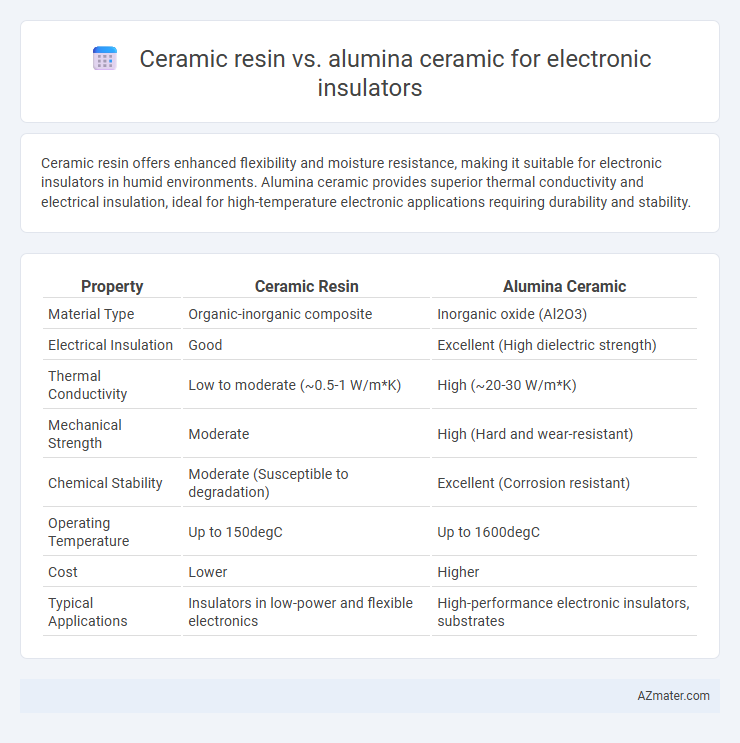Ceramic resin offers enhanced flexibility and moisture resistance, making it suitable for electronic insulators in humid environments. Alumina ceramic provides superior thermal conductivity and electrical insulation, ideal for high-temperature electronic applications requiring durability and stability.
Table of Comparison
| Property | Ceramic Resin | Alumina Ceramic |
|---|---|---|
| Material Type | Organic-inorganic composite | Inorganic oxide (Al2O3) |
| Electrical Insulation | Good | Excellent (High dielectric strength) |
| Thermal Conductivity | Low to moderate (~0.5-1 W/m*K) | High (~20-30 W/m*K) |
| Mechanical Strength | Moderate | High (Hard and wear-resistant) |
| Chemical Stability | Moderate (Susceptible to degradation) | Excellent (Corrosion resistant) |
| Operating Temperature | Up to 150degC | Up to 1600degC |
| Cost | Lower | Higher |
| Typical Applications | Insulators in low-power and flexible electronics | High-performance electronic insulators, substrates |
Introduction to Electronic Insulators
Ceramic resin and alumina ceramic are common materials used for electronic insulators, each offering unique properties for electrical isolation. Ceramic resin provides flexibility and lightweight characteristics, while alumina ceramic is renowned for its high thermal conductivity, excellent electrical insulation, and mechanical strength. The choice between these materials depends on application requirements such as temperature resistance, dielectric strength, and mechanical durability in electronic device manufacturing.
Overview of Ceramic Resin Materials
Ceramic resin materials for electronic insulators typically combine polymer matrices with ceramic fillers to enhance mechanical strength, thermal stability, and electrical insulation properties. These composites offer improved fracture toughness and flexibility compared to pure alumina ceramics, making them suitable for applications requiring lightweight and durable insulation. The resin's tailored chemistry allows customization of thermal conductivity and dielectric constants to meet specific electronic performance requirements.
Alumina Ceramic: Composition and Properties
Alumina ceramic, primarily composed of aluminum oxide (Al2O3), offers superior electrical insulation, high thermal conductivity, and exceptional mechanical strength, making it ideal for electronic insulators in high-performance applications. Its excellent dielectric strength, typically around 10-15 kV/mm, ensures reliable insulation under high voltage conditions, while its thermal stability up to 1700degC supports efficient heat dissipation. Compared to ceramic resin, alumina ceramic provides enhanced wear resistance, chemical inertness, and dimensional stability, crucial for durability and consistent electronic device performance.
Electrical Insulation Performance Comparison
Ceramic resin typically offers lower dielectric strength and higher moisture absorption compared to alumina ceramic, impacting its reliability as an electronic insulator. Alumina ceramic exhibits superior electrical insulation performance due to its high dielectric strength, low dielectric loss, and excellent thermal stability, making it ideal for high-voltage and high-frequency applications. The dense microstructure and high purity of alumina ceramic ensure minimal electrical conductivity and enhanced insulation resistance over extended operational periods.
Thermal Conductivity and Heat Resistance
Ceramic resin typically offers moderate thermal conductivity around 0.5 to 2 W/mK, suitable for applications with limited heat dissipation requirements, while alumina ceramic boasts significantly higher thermal conductivity, often exceeding 20-30 W/mK, making it ideal for efficient heat transfer in electronic insulators. Alumina ceramic also demonstrates superior heat resistance, withstanding temperatures above 1500degC, compared to ceramic resin's lower thermal stability, generally limited to below 300degC. These properties make alumina ceramic the preferred material for high-performance electronic insulators requiring effective thermal management and durability under extreme thermal conditions.
Mechanical Strength and Durability
Ceramic resin insulators typically offer moderate mechanical strength with enhanced flexibility, making them resistant to impact and vibration in electronic applications. Alumina ceramic insulators exhibit superior mechanical strength, high hardness, and excellent thermal stability, resulting in exceptional durability under harsh environmental conditions. The high fracture toughness and wear resistance of alumina ceramic make it a preferred choice for long-term reliability in electronic insulation.
Manufacturing Processes and Scalability
Ceramic resin insulators are manufactured through polymer infiltration and curing processes, allowing precise control over shape and thickness, leading to efficient scalability in mass production. Alumina ceramic insulators require high-temperature sintering and machining, which are energy-intensive and less adaptable to rapid manufacturing scale-up. The ease of forming and curing ceramic resin composites supports cost-effective large-scale fabrication, while alumina's complex processing limits scalability despite superior thermal and electrical properties.
Cost Considerations and Availability
Ceramic resin insulators generally offer lower production costs and greater availability due to simpler manufacturing processes and widespread raw material sourcing. Alumina ceramic, while more expensive because of its high purity and dense microstructure, provides superior electrical insulation and thermal stability, justifying the premium in high-performance applications. Cost-sensitive projects favor ceramic resin, whereas alumina ceramic suits environments demanding enhanced durability and reliability despite higher upfront investment.
Applications in Electronics Industry
Ceramic resin insulators are widely used in flexible electronic components and circuit boards due to their excellent dielectric properties and ease of molding into complex shapes. Alumina ceramic insulators provide superior thermal conductivity and mechanical strength, making them ideal for high-power electronic devices, substrates, and heat sinks. In the electronics industry, alumina ceramics dominate applications requiring high-temperature resistance and electrical insulation performance, while ceramic resin is preferred for lightweight, cost-effective, and customized insulation solutions.
Future Trends and Material Innovations
Ceramic resin and alumina ceramic both play crucial roles as electronic insulators, with alumina ceramic offering superior thermal conductivity and mechanical strength, making it ideal for high-power and high-frequency applications. Future trends emphasize developing ceramic resins with enhanced dielectric properties and flexibility to accommodate miniaturized and wearable electronics. Material innovations focus on nanocomposites and hybrid ceramics that combine the high insulation of ceramic resin with the robustness of alumina to improve performance and reliability in next-generation electronic devices.

Infographic: Ceramic resin vs Alumina ceramic for Electronic insulator
 azmater.com
azmater.com